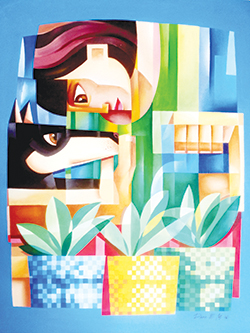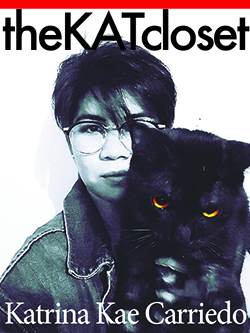If you are an artist, you are highly advised or inclined to think outside the box; but if you are a great artist, you reinvent the box and endow it with different perspectives. Cubism has been considered the most influential avant-garde art movement of the 20th century, pioneered by the Spaniard Pablo Picasso and the Frenchman Georges Braque. A cubist painter’s aim is to levitate the two-dimensionality of a canvas instead of just copying and representing nature as is and applying traditional techniques of perspective.
A Davao artist and teacher, Mr. Donn Manguilimotan is a cubist whose works I could really not forget when I saw him at the “About” art event at People’s Park. “I am self-taught and very thankful for this wonderful God-given talent. It grows along with me as I also develop as an artist from being motivated by other painters in my community since I know there are better painters out there than me; but what inspires me the most is still Maestro Vicente Manansala’s cubic line faded technique,” Donn humbly states.
 Evocative of Manansala’s works, Donn portrays Filipino life and scenes that is mostly highlighted at celebrations/fiestas and the feeling of light happiness. “Even though my technique is of modern cubic style, I depict traditional subjects and settings on my canvas—it is still a Barrio-style fiesta or a provincial event with Filipinos wearing vintage clothing—I guess it is my way of merging opposing poles together to make tradition more aesthetically appealing,” the artist shares.
Evocative of Manansala’s works, Donn portrays Filipino life and scenes that is mostly highlighted at celebrations/fiestas and the feeling of light happiness. “Even though my technique is of modern cubic style, I depict traditional subjects and settings on my canvas—it is still a Barrio-style fiesta or a provincial event with Filipinos wearing vintage clothing—I guess it is my way of merging opposing poles together to make tradition more aesthetically appealing,” the artist shares.
What came first—the chicken or the egg? What came first, abstract art or cubism? Unlike the former, age-old question, the answer is clear that cubism is actually not just another facet of abstract art, but directly influenced it in the 20th century. In Analytic Cubism, portions of the same subject is dissected and reassembled again to symbolically show a more three-dimensional space or illusion for a more attention-grabbing painting.
“Being a painter, I use my hand and mind to create new things and discover concepts that reflect my artistic personality. As a cubist, my painting is literally a relation of all sides and corners of my subject that I piece together to try and replicate its wholeness in real life,” Donn says.
The artist’s colors are mostly glowing and joyful just like the subject and events he is drawing vision from—and just like real-life Filipino fiestas and celebrations, his works seem to have a feeling of disarray of hues and elements but at the same time it is light and well-organized on the eyes that counter intuitively give out an impression of jubilant calmness.
What is most interesting in the cubism technique is its attempt in breaking past rules of space and time to give a fuller and detailed explanation of the subject and I think everyone who truly appreciates cubism have a deeper understanding and relation of it with life itself—it’s about seeing the same things or situations in different perspectives and piecing together minute parts of our lives that we deem we learned something good from, and then piecing it all together to form a better and more fascinating human being.







